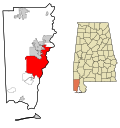Weems House | |
 The Weems House in 2010 | |
| Location | 1155 Springhill Avenue Mobile, Alabama |
|---|---|
| Coordinates | 30°41′30″N88°3′46″W / 30.69167°N 88.06278°W |
| Area | 0.3 acres (0.12 ha) |
| Built | 1870 |
| Architectural style | Greek Revival |
| NRHP reference No. | 82001613 [1] |
| Added to NRHP | October 07, 1982 |
The Weems House, also referred to as Fowler Cottage, stands as a historic residence in Mobile, Alabama. Constructed in 1870, this single-story building exemplifies the late Greek Revival-style. Recognized on October 7, 1982, it was listed on the register National Register of Historic Places . [1] Initially serving as a private residence, it transitioned ownership on July 18, 1991, when acquired by the Dragons Civic and Social Club, a local fraternal organization. [2] [3]



